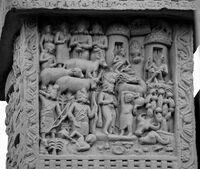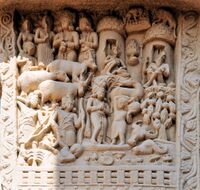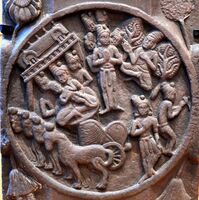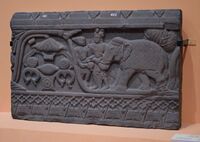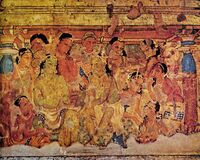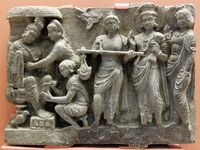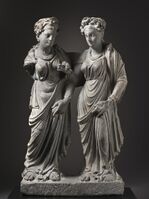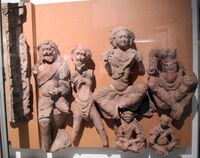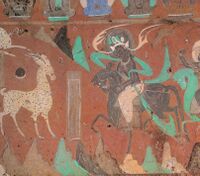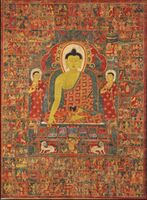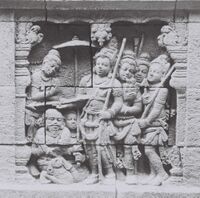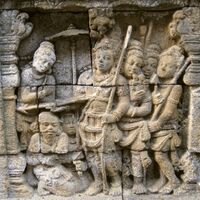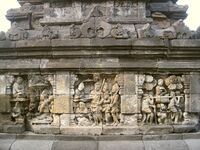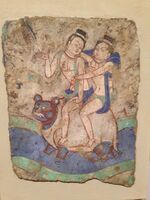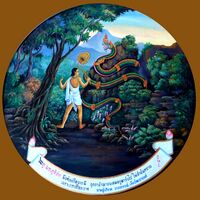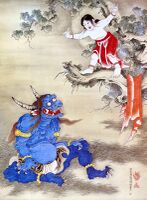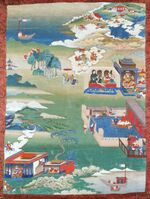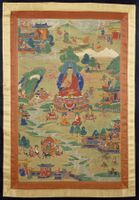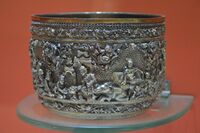حكايات جاتاكا
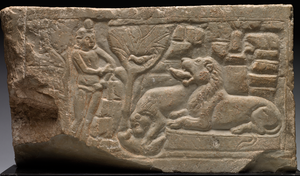
| ترجمات Jātaka tales | |
|---|---|
| الإنگليزية | Birth history |
| سنسكريت | जातक |
| البورمية | ဇာတက |
| الخمير | ជាតក |
| سنهالا | ජාතක කථා (Jātaka Kathā) |
| تاي | ชาดก |
| معجم البوذية | |
The Jātaka (Sanskrit for "Birth-Related" or "Birth Stories") are a voluminous body of literature native to the Indian subcontinent which mainly concern the previous births of Gautama Buddha in both human and animal form. Jataka stories were depicted on the railings and torans of the stupas. [1][2] According to Peter Skilling, this genre is "one of the oldest classes of Buddhist literature."[3] Some of these texts are also considered great works of literature in their own right.[4]

In these stories, the future Buddha may appear as a king, an outcast, a deva, an animal—but, in whatever form, he exhibits some virtue that the tale thereby inculcates.[5] Often, Jātaka tales include an extensive cast of characters who interact and get into various kinds of trouble - whereupon the Buddha character intervenes to resolve all the problems and bring about a happy ending. The Jātaka genre is based on the idea that the Buddha was able to recollect all his past lives and thus could use these memories to tell a story and illustrate his teachings.[6]
For the Buddhist traditions, the jātakas illustrate the many lives, acts and spiritual practices which are required on the long path to Buddhahood.[1] They also illustrate the great qualities or perfections of the Buddha (such as generosity) and teach Buddhist moral lessons, particularly within the framework of karma and rebirth.[7] Jātaka stories have also been illustrated in Buddhist architecture throughout the Buddhist world and they continue to be an important element in popular Buddhist art.[7] Some of the earliest such illustrations can be found at Sanchi and Bharhut.
According to Naomi Appleton, Jātaka collections also may have played "an important role in the formation and communication of ideas about buddhahood, karma and merit, and the place of the Buddha in relation to other buddhas and bodhisattvas."[7] According to the traditional view found in the Pali Jātakanidana, a prologue to the stories, Gautama made a vow to become a Buddha in the future, in front past Buddha Dipankara. He then spent many lifetimes on the path to Buddhahood, and the stories from these lives are recorded as Jātakas.[8]
Jātakas are closely related to (and often overlap with) another genre of Buddhist narrative, the avadāna, which is a story of any karmically significant deed (whether by a bodhisattva or otherwise) and its result.[2][9] According to Naomi Appleton, some tales (such as those found in the second and fourth decade of the Avadānaśataka) can be classified as both a jātaka and an avadāna.[9]
. . . . . . . . . . . . . . . . . . . . . . . . . . . . . . . . . . . . . . . . . . . . . . . . . . . . . . . . . . . . . . . . . . . . . . . . . . . . . . . . . . . . . . . . . . . . . . . . . . . . . . . . . . . . . . . . . . . . . . . . . . . . . . . . . . . . . . . . . . . . . . . . . . . . . . . . . . . . . . . . . . . . . . . .
استعراض
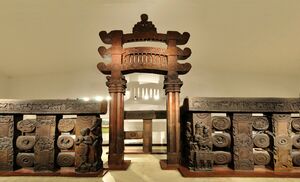
التأريخ
Jātaka tales may be quite ancient. The term appears as part of a schema of Buddhist literary forms called the nine component genres of the Buddha's teaching (navaṅga-buddhasāsana), and depictions of them appear in early Indian art (as early as the second century BCE).[6][10] They are also widely represented in ancient Indian inscriptions.[11] According to Straube, "the presumably oldest specimens of fully elaborated narratives are dispersed throughout the Vinayapiṭakas and Sūtrapiṭakas of the canonical collections of the different Buddhist schools. These texts are transmitted in various Indian dialects and stem from a prior oral tradition."[2]
Furthermore, while these texts cannot be dated in a precise manner, "the fact that many narratives are passed on in almost identical form within the canons of the different schools shows that they date back to the time before the schisms between the schools took place."[2] Sarah Shaw, writing on the Pali Jātaka, states that the earliest part of the Jātaka, the verse portions, are "considered amongst the very earliest part of the Pali tradition and date from the fifth century BCE" while "the later parts were incorporated during the period up to the third century CE."[8]
According to A. K. Warder, jātaka are the precursors to the various legendary biographies of the Buddha, which were composed at later dates.[12] Although many jātaka were written from an early period, which describe previous lives of the Buddha, very little biographical material about Gautama's own life has been recorded.[12] Jātaka tales also assimilate many traditional Indian fables and folklore that are not specifically Buddhist. As the genre spread outside of India, it also drew on local folk tales.[6]
السمات الأدبية والمواضيع
The Mahayana author Asaṅga provides a working definition of jātaka in his Śrāvakabhūmi:[13]
What is jātaka? That which relates the austere practices and bodhisattva practices of the Blessed One in various past births: this is called jātaka.
The idea that jātaka are taught in order to illustrate the bodhisattva path is an ancient one and is contained in sources like the Mahavastu, which states: "the supreme ones [Buddhas], who are skilled in jātakas and other doctrines, teach the course of practice of a bodhisattva."[11]
Many jātakas are told with a common threefold plot schema which contains:[2]
- a “narrative in the present” (paccupannavatthu), with the Buddha and other figures,
- a “narrative in the past” (atītavatthu), a story from a past life of the Buddha
- a "link" (samodhāna) in which there is an “identification of the past protagonists with the present ones.”[2]
In the jātaka found in the Suttapitaka, which are almost always in prose, the Buddha is almost always depicted as a person of high rank in a past life (and not an animal). Some of these also include past lives of some of the Buddha's disciples.[2][11] One famous example is the Pali Mahāparinirvāṇasūtra, which includes the story of Mahāsudarśana.[2] Unlike Sutra collections, Vinaya sources like the Vinayavastu contain more varied jātakas, including ones in which the Buddha is depicted as an animal.[2]
Many jātaka contain elements of both verse and prose. According to Martin Straube "the division into canonical verses and postcanonical prose points to the old Indian narrative form of ākhyāna, which has a fixed wording of the stanzas only, whereas the actual story is to be shaped anew during each oral performance."[2] The plots of the jātaka range from simpler Aesopic style animal tales to longer more complex dramas which resemble epics or novels with intricate dialogue, characters and poetry. Despite the diversity of the plots and characters, they are all unified by the character of the heroic bodhisattva Gautama (whose identity is generally only revealed at the end of the story) and his struggles on the quest for awakening.[4] In spite of this, Gautama is not always the central character of all these stories and sometimes only plays a minor role.[14] Other recurring characters include important disciples of the Buddha, Devadatta (generally as an villain) and members of Gautama's family, like his wife Yasodharā and son Rāhula.[14]
Another important element of the stories are the various Buddhist virtues, called perfections, that were cultivated by the bodhisattva Gautama throughout his previous lives, and which serve as the lessons taught by the jātakas.[15] Other jātakas, such as those found in the Buddhavaṃsa (Chronicle of Buddhas), focus on Gautama's meeting, serving and venerating past Buddhas and serve to place his bodhisattva path in a chronology of past Buddhas. These stories generally focus on acts of devotion to past Buddhas and how this generates much merit which many positive outcomes in the future.[9] A smaller number of jātakas illustrate various mistakes or bad actions that the bodhisattva committed in a past life (and the subsequent karmic retribution) and thus demonstrate the bodhisattva's past imperfections.[9]
Regarding the intended audience of these texts, Martin Straube notes that even though there is a widespread view that jātakas arose due to monks "catering to the needs and tastes of the illiterate lay practitioners of Buddhism as propagandistic means of preaching or converting" there is no historical evidence for this.[2] Instead, the opposite might be true, since "the prose portions of the Pali jātakas not infrequently have as their audience monks and nuns, who sometimes reach high levels of spiritual realization after listening to a jātaka story."[2] Naomi Appleton, in her analysis of the second and fourth decade of the Avadānaśataka, notes that both sets of stories "assume a monastic audience."[9] Likewise, Kate Crosby writes that "the format of the Jātaka in fact suggests that their original inclusion in the canonical collection was primarily for the benefit of monks."[16] Crosby notes that many of these stories are connected with monastic behavior and decorum, some of them are also meant to illustrate specific rules in the Vinaya. In spite of this main intended audience, their simple format also made them easily adaptable for other uses. Thus, they were repackaged as artistic entertainment and teaching devices for laypersons, as parittas (protective chants) and as chronicle (vamsa) literature.[16]
Straube also notes that the rock caves of Ajanta and Bagh were inhabited by monks and it was them who ordered and directed the jātaka murals found there. There is also evidence from inscriptions on old stūpas at various Indian sites (such as Sanchi and Bharhut) with jātaka motifs which indicate that they were built due to the patronage of monks and nuns, some of them of high rank such as bhāṇaka (reciter).[2] Some scholars have also concluded that Jātaka reciters were part of their own division of reciters.[11]
التاريخ
Jātakas were originally transmitted in prakrit languages and various forms of Sanskrit (from classical to Buddhist Hybrid Sanskrit). They were then translated into central Asian languages (such as Khotanese, Tocharian, Uighur, and Sogdian).[17] Various jātaka stories and source texts were also translated into Chinese and Tibetan for the Tibetan and Chinese Buddhist canons.[6] They were some of the first texts to be translated into Chinese. Kāng Sēnghuì (who worked in Nanking c. 247) was one of the first Chinese translators of Jātakas. Perhaps his most influential translation is the Scripture of the Collection of the Six Perfections.[17]
The various Indian Buddhist schools had different collections of jātakas. The largest known collection is the Jātakatthavaṇṇanā of the Theravada school.[7] In Theravada Buddhism, the Jātakas are a textual division of the Pāli Canon, included in the Khuddaka Nikaya of the Sutta Pitaka. The term Jātaka may also refer to a traditional commentaries (Atthakatha) on this book. The tales are dated between 300 BCE and 400 CE.[18]
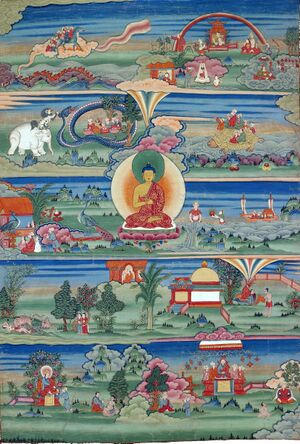
The Mahāsāṃghika Caitika sects from the Āndhra region also had Jātakas as part of their canon and they are known to have rejected some of the Theravāda Jātakas which dated past the time of King Ashoka.[19] The Caitikas claimed that their own Jātakas represented the original collection before the Buddhist tradition split into various lineages.[20]
In the Northern Buddhist tradition, Jātakas eventually came to be composed in classical Sanskrit. Perhaps the most influential and important Sanskrit Jātaka text is the Jātakamālā (Garland of Jātakas) of Āryaśūra which includes 34 Jātaka stories.[21] This work differs from earlier sources in that it is a highly sophisticated poem which makes use of various Sanskrit literary devices.[22] The Jātakamālā was quite influential and was imitated by later authors who wrote their own jātakamālās, mainly Haribhaṭṭa and Gopadatta. These works are all written in a classical Sanskrit genre known as campū, which is a blend of prose and verse in various meters. The jātakamālās all also use the six perfections (pāramitā) as their main framework.[2] The influence of the jātakamālās can be seen in the Ajanta Cave complex, where illustrations of Jātakas are inscribed with quotes from Āryaśūra,[23] with script datable to the sixth century. The Jātakamālā was also translated into Chinese in 434 CE. Borobudur, a massive 9th century Buddhist site in Java, contains depictions of all 34 Jatakas from the Jātakamālā.[24]
Two other Sanskrit authors associated with the jātaka genre are Kumāralāta (2nd century CE), author of the Kalpanāmaṇḍitikā Dṛṣṭāntapaṅkti (Collection of Examples, Adorned with an Artistic Arrangement) and Saṅghasena's (date unknown) Pusa benyuan jing (菩薩本縁經; Sūtra of the Bodhisattva’s Avadānas). Both works exist only in Chinese translation (but there are Sanskrit fragments). These texts are a kind of predecessor to the Jātakamālā and are less poetically sophisticated.[2]
Later Sanskrit authors continued to write in the genre. One such late text is Kṣemendra's (c. 1036–1065) Bodhisattvāvadānakalpalatā (Wish-Fulfilling Creeper Consisting in Avadānas of the Bodhisattva), a unique jātaka text written completely in verse. This work was influential on the Tibetan tradition.[2]
Jātaka are also important in Tibetan Buddhism. They were one of the main sources of teaching and study for the popular Kadam school and later Tibetan authors produced abridged collections such as Karmapa Rangjung Dorje's Hundred Births and Padma Chopel's summary of the Avadānakalpalatā.[25]
. . . . . . . . . . . . . . . . . . . . . . . . . . . . . . . . . . . . . . . . . . . . . . . . . . . . . . . . . . . . . . . . . . . . . . . . . . . . . . . . . . . . . . . . . . . . . . . . . . . . . . . . . . . . . . . . . . . . . . . . . . . . . . . . . . . . . . . . . . . . . . . . . . . . . . . . . . . . . . . . . . . . . . . .
المصادر الكلاسيكية للجاتاكا
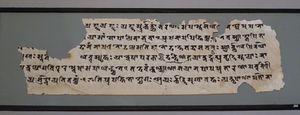

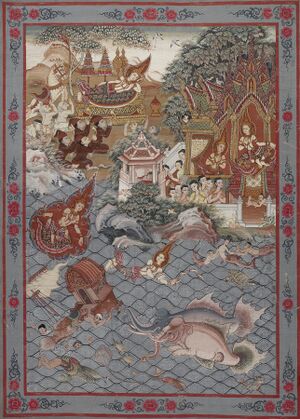
There are numerous sources for classic or canonical Jātaka tales, including:[26][2]
- The various Vinayapiṭakas and Sūtrapiṭakas of the different canons of the early Buddhist schools
- The Gandharan Buddhist texts contain many Jātaka narratives, though here they are more commonly termed pūrvayogas ("former connection")
- The Jātakatthavaṇṇanā, the Theravada Jātaka collection (part of the Khuddaka Nikāya) contains 547 Jātakas in mixed verse (gāthās) and prose and was collected around 500 CE. It is preceded by the Nidānakathā, which is a biography of the Buddha which relates the stories to his life. It is the largest collection of Jātakas.[7]
- The Cariyāpiṭaka, a treatise on the bodhisattva paramis, which includes 35 Jātakas.[6]
- Kumāralāta's (2nd century CE) Kalpanāmaṇḍitikā Dṛṣṭāntapaṅkti (Collection of Examples, Adorned with an Artistic Arrangement)
- Saṅghasena's (date unknown) Pusa benyuan jing (菩薩本縁經; Sūtra of the Bodhisattva’s Avadānas)
- An untitled collection of Sanskrit avadānas and jātakas found in the Merv oasis dated to the 5th century CE
- All the Pali commentaries (Aṭṭhakathā) on the Vinayapiṭaka and Suttapiṭaka contain Jātakas, the commentary on the Dhammapada is a popular and well known source.
- The Buddhavaṃsa (Chronicle of the Buddhas) a hagiographical text of the Sinhalese Theravada school
- The Mahāvastu (Great Event), a text of the Mahāsāṅghika Lokottaravāda school, contains many jātakas and avadānas
- The Vinayavastu of the Mūlasarvāstivāda school (which only survives in complete form in Tibetan translation), contains many jātakas and avadānas
- The Avadānaśataka (The Hundred Avadānas, c. 2nd-6th century CE) contains various "Jātakāvadānas".[27]
- The Karmaśataka
- The Divyāvadāna (Heavenly Avadānas)
- The commentary on the Udānavarga by Prajñāvarman (8th century), which survives in Tibetan, contains numerous Jātakas
- Lalitavistara (The Play in Full), a biography of the Buddha containing various Jātakas.
- The Liu du ji jing (六度集經, Scripture of the Collection of the Six Perfections, Taisho 152), translated by Kang Senghui (?–280) in the third century CE.[28]
- Jātaka Sūtra (Sheng jing, 生經, Taisho Tripitaka 154), a Chinese collection of 55 Jātakas translated into Chinese by Dharmaraksa (3rd century).[28]
- The Xian yu jing (賢愚經, Taisho 202), with 69 stories.[28]
- The Da zhuang yan lun jing (大莊嚴論經, *Kalpanāmaṇḍitikā, Taisho 201), translation by Kumārajīva, with 90 stories.[28]
- The Jātakamālā (Garland of Jātakas), a series of classical Sanskrit kāvya poems by Āryaśūra (4th century), contains 34 Jātakas.[21]
- Haribhaṭṭa's Jātakamālā (Sanskrit)
- Sarvarakṣita's Maṇicūḍajātaka (12th-century), a Sāṃmitīya school text in 376 kāvya style stanzas.
- The Sutra of the Wise and the Foolish (Skt. Damamūka-nidāna-sūtra; Tibetan: mdo mdzangs blun; Chinese: hsien-yü ching)
- Many Mahayana sutras contain Jātakas embedded into them. For example, the Bodhisattvapiṭaka-sutra contains numerous Jātakas which are used to illustrate the various bodhisattva qualities.[29] Likewise, Jātakas are an important element in the Large Prajñāpāramitā sutra, the Suvarṇaprabhāsa sūtra and the Bhadrakalpikasūtra.[3] The Bhadrakalpikasūtra has a long section on the six perfections which includes around one hundred past life stories, including jātakas, pūrvayogas, and avadānas.[30]
- The Dà zhìdù lùn (大智度論) a massive Mahāyāna Buddhist treatise and commentary which survives in Chinese translation by Kumarajiva, contains numerous Jātakas which are used to illustrate the six perfections as well as other topics.[31]
- Kṣemendra's (c. 1036–1065) Bodhisattvāvadānakalpalatā (Wish-Fulfilling Creeper Consisting in Avadānas of the Bodhisattva)
الجاتاكا المتأخرة
Within the Pali tradition, there are also many non-canonical Jātakas of later composition (some dated even to the 19th century) but these are treated as a separate category of literature from the "official" Jātaka stories that have been more or less formally canonized from at least the 5th century — as attested to in ample epigraphic and archaeological evidence, such as extant illustrations in bas relief from ancient temple walls. Apocryphal Jātakas of the Pali Buddhist canon, such as those belonging to the Paññāsa Jātaka collection, have been adapted to fit local culture in certain South East Asian countries and have been retold with amendments to the plots to better reflect Buddhist morals.[32][33] According to Kate Crosby, "there is also a collection of Jātaka of ten future Buddhas, beginning with Metteyya, which though less well-known today clearly circulated widely in the Theravada world."[34]
There are also late compositions based on classic Jātakas, such as the Kavsiḷumiṇa, a poem based on the Kusa Jātaka in archaic Sinhala written King Parākkamabāhu II (13th century) and the Mahachat kham luang, the ‘royal version' of the Vessantara jātaka, which was composed at the court of King Paramatrailokanātha (c. 1482). The art of putting classic Jātakas into Thai verse remains a living tradition to this day.[35][34]
الجاتاكا الهامة
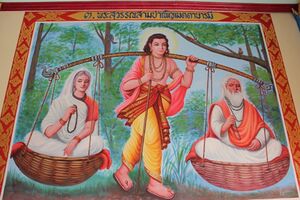
في الثراڤادا
The Theravāda Jātakas comprise 547 poems, arranged roughly by an increasing number of verses. According to Professor von Hinüber,[36] only the last 50 were intended to be intelligible by themselves, without commentary. The commentary gives stories in prose that it claims provide the context for the verses, and it is these stories that are of interest to folklorists. Alternative versions of some of the stories can be found in another book of the Pali Canon, the Cariyapitaka, and a number of individual stories can be found scattered around other books of the Canon. Many of the stories and motifs found in the Jātaka such as the Rabbit in the Moon of the Śaśajātaka (Jataka Tales: no.316),[37] are found in numerous other languages and media.
For example, The Monkey and the Crocodile, The Turtle Who Couldn't Stop Talking and The Crab and the Crane that are listed below also famously featured in the Hindu Panchatantra, the Sanskrit niti-shastra that ubiquitously influenced world literature.[38] Many of the stories and motifs are translations from the Pali but others are instead derived from vernacular oral traditions prior to the Pali compositions.[39] At the Mahathupa in Sri Lanka all 550 Jataka tales were represented inside of the reliquary chamber.[40] Reliquaries often depict the Jataka tales.
In Southeast Asia, the most important and widely known stories are the 10 stories of the Mahānipāta jātaka (Ten Great Birth Stories). These tales are considered to be the ten final lives of the bodisattva Gautama and are said to have been the completion of the 10 paramis or perfections.[41] Of these, the Vessantara is the most popular. According to Peter Skilling, part of the reason for its popularity "was the pervasive belief, spread through the Māleyya-sutta and related literature, that by listening to this jātaka one could be assured of meeting the next Buddha, Metteya."[42]
The following list includes some important jātakas of the Pali tradition:
- The Ass in the Lion's Skin (Sīhacamma Jātaka)
- The Banyan Deer
- The Cock and the Cat (Kukkuṭa Jātaka)
- The Crab and the Crane
- The Elephant Girly-Face
- The Monkey King (Mahakapi Jataka)
- The Foolish, Timid Rabbit (Daddabha Jātaka)
- Four Harmonious Animals
- The Great Ape
- How the Turtle Saved His Own Life
- The Jackal and the Crow (Jambu-Khādaka Jātaka)
- The Jackal and the Otters (Dabbhapuppha Jātaka)
- The King's White Elephant
- The Lion and the Woodpecker (Javasakuṇa Jātaka)
- The Measure of Rice
- The Merchant of Seri
- The Monkey and the Crocodile
- The Ox Who Envied the Pig (Muṇika-Jātaka)
- The Ox Who Won the Forfeit
- The story of Romaka pigeon (Romaka Jātaka, previous life of the Buddha as a pigeon).[43]
- Prince Sattva
- The Princes and the Water-Sprite
- The Quarrel of the Quails
- The Swan with Golden Feathers (Suvaṇṇahaṃsa Jātaka)
- King Sibi
- King Dasharatha
- The Tiger, the Brahmin and the Jackal
- The Turtle Who Couldn't Stop Talking (Kacchapa Jātaka)
- The Twelve Sisters
- The Wise and the Foolish Merchant
- Vessantara Jataka
- Why the Owl Is Not King of the Birds
Āryaśūra's Jātakamālā
Āryaśūra's Jātakamālā, a very influential Sanskrit work that was depicted throughout the Buddhist world, contains the following Jātakas (which teach various virtues):[44]
- The Story of the Tigress (focuses on the perfection of Dāna, giving)
- The Story of the King of the Śibis (Dāna)
- The Story of the Small Portion of Gruel (Dāna)
- The Story of the Head of A Guild (Dāna)
- The Story of Aviṣahya, the Head of a Guild (Dāna)
- The Story of the Hare (Dāna)
- The Story of Agastya (Dāna)
- The Story of Maitrībala (Dāna)
- The Story of Viśvantara (Dāna)
- The Story of the Sacrifice (teaches Śīla, morality)
- The Story of Sakra (Karuṇā, compassion)
- The Story of the Brāhman (Hrī, self-respect)
- The Story of Unmādayantī (Dhairya, “self-control”)
- The Story of Supāraga (Sacca, truth)
- The Story of the Fish (Sacca, truth)
- The Story of the Quail's Young (Sacca, truth)
- The Story of the Jar (Vāra, excellence)
- The Story of the Childless One (Praviveka, seclusion)
- The Story of the Lotus-Stalks (Praviveka)
- The Story of the Treasurer (Hrī)
- The Story of Cuḍḍabodhi (Khanti, patient acceptance)
- The Story of the Holy Swans (Maitrī, loving-kindness)
- The Story of Mahābodhi (Khanti)
- The Story of the Great Ape (Anukampā, compassion)
- The Story of the Śarabha (Anukampā)
- The Story of the Ruru-Deer (Dayā, kindness)
- The Story of the Great Monkey (Anuvartinā, obedience)
- The Story of Kṣāntivādin (Khanti)
- The Story of the Inhabitant of the Brahmaloka (Anukampā)
- The Story of the Elephant (Karuṇā)
- The Story of Sutasoma (Satsaṁga, goodness)
- The Story of Ayogṛha (Saṃvega, spiritual urgency)
- The Story of the Buffalo (Khanti)
- The Story of the Woodpecker (Khanti)
. . . . . . . . . . . . . . . . . . . . . . . . . . . . . . . . . . . . . . . . . . . . . . . . . . . . . . . . . . . . . . . . . . . . . . . . . . . . . . . . . . . . . . . . . . . . . . . . . . . . . . . . . . . . . . . . . . . . . . . . . . . . . . . . . . . . . . . . . . . . . . . . . . . . . . . . . . . . . . . . . . . . . . . .
Jātakas in art and culture
Jātakas have been important as a way to spread Buddhist teachings and they were widely used as part of sermons, rituals, festivals, and various forms of art. Kate Crosby writes that they have been depicted in such varied forms as "apocryphal literature, vernacular retellings, performance, temple art, temporary street and festival art, films, comics, and cartoons."[45] The sponsorship of Jātaka recitations, copyings and art eventually grew to be seen as an act which generated merit for lay Buddhists. These acts are more common around important festivals like Vesak.[46]
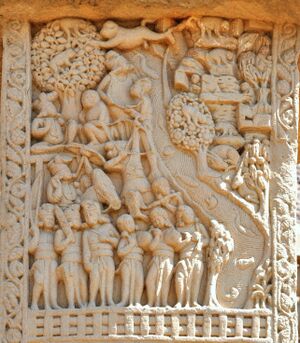
The earliest archeological findings which depict Jātakas are the illustrations found in the on the Bharhut stupa railing as well as at Sanchi (c. late 2nd - 1st century BCE), which also include inscriptions.[47][2] After this, Jātakas appear at many Buddhist sites, like at Ajanta. Similar Jātaka tales are found in murals of Silk Road sites of the pre-Tang period (ca. 421–640 C.E.), such as at Kucha. They are also found in early Southeast Asian sites, especially at Bagan sites. Burmese Buddhism has an extensive tradition of Jātaka illustration, one of the best examples being the illustrations found at Ananda Temple (which depicts 554 tales).[47]

Jātaka tales are often associated with specific locations. Originally, this applied to specific places in India, which served as Buddhist pilgrimage sites. Later traditions expanded this to include other places throughout the Buddhist world. According to Naomi Appleton, the fact that Jātaka tales lack specific references to specific places allowed them to be easily transported and re-localized. This flexibility contributed to the lasting popularity of the Jātakas.[48] This tradition of associating Jātaka tales with regions outside of India played an important part in the promotion and legitimisation of Buddhism in these regions.[48]
Thus, many stupas in Nepal and northern India are said to mark locations from the Jātaka tales. Chinese pilgrims like Xuanzang and Faxian reported several of these and discussed the stories connected with them. Sites discussed by these figures include the "four great stupas" as well as stupas in Pushkalavati, Mangalura, Hadda Mountain, and Sarvadattaan.[49][50]
According to Naomi Appleton, the "four great stupas" visited by Faxian (337–422 CE) are:
the first (in ‘So-ho-to’) was where the Buddha ransomed the life of a dove with his own flesh; the second (in Gandhāra) was where he gave away his eyes to a blind beggar; and the third and fourth (in Takshaśilā) were where he gave away his head to a man and his whole body to a starving tigress who was about to eat her own cubs, and where ‘kings, ministers, and peoples of all the kingdoms around vie with one another in making offerings’. A century later, Songyun writes of the same four sites and also mentions a whole area associated with the Vessantara-jātaka.[48]
Artistic depictions at major sites
Numerous Indian Buddhist archeological sites contain illustrations of Jātakas, and thus they are important artistic sources for Jātakas. Some of the main sites include:[26][2]
Other ancient sites outside of India which contain Jataka illustrations include Borobudor, Dunhuang (the Mogao caves), Polonnoruwa, Anuradhapura, Bagan city, and Nakhon Pathom.[51] Jataka illustrations (especially of the last 10 stories of the canonical Pali collection) are widespread in the Theravada Buddhist world, adorning many temples, wats and key sites.[52]
Performance
According to the Chinese pilgrim Yijing, who visited India in the 7th century, jātaka plays were performed ‘throughout the five countries of India’. This culture of performance spread to other regions as well.[25]
In Tibet, the Viśvāntara-jātaka was transformed into a popular play called the Dri med kun ldan. Other popular jataka plays include Nor bzaṅ or Sudhana and the story of Prince Maṇicūḍa (Lokānanda).[25]
In Theravada countries, several of the longer tales such as "The Twelve Sisters"[53] and the Vessantara Jataka[54] are still performed in dance,[55] theatre, puppetry,[52] and formal (quasi-ritual) recitation.[56] Such celebrations are associated with particular holidays on the lunar calendar used by Thailand, Myanmar, Sri Lanka and Laos. The recitation of the Vessantara Jataka remains an important ceremony remains an important ceremony in Theravada countries today.[57]
Gallery
Vessantara Jataka, Bharhut, Shunga period
Dipankara Jataka, Jamalgarhi
Nine-colored deer jataka. Northern Wei. Mogao cave 257
Khudda-bodhi-Jataka, Borobudur
Kucha, Turtle King Jataka
English Translations
The standard Pali collection of jātakas, with canonical text embedded, has been translated by E. B. Cowell and others, originally published in six volumes by Cambridge University Press (1895–1907) and reprinted in three volumes, by the Pali Text Society (Bristol).[58] There are also numerous English translations of selections and individual stories from various sources.
Some of the main translations of jātakas available in English include:
- Bhikshu Dharmamitra, trans. Marvelous Stories from The Perfection of Wisdom: 130 Didactic Stories from Ārya Nāgārjuna’s Exegesis on the Great Perfection of Wisdom Sutra. Kalavinka Press, 2008.
- Burlingame, E.W., trans., Buddhist Legends: Translated from the Original Pali Text of the Dhammapada Commentary , 3 vols., HOS 28–30, Cambridge MA, 1921.
- Cowell, E.B., & R.A. Neil, eds.,The Jātaka or Stories of the Buddha’s Former Births, 6 vols., Cambridge UK, 1895–1907.
- Cowell, E.B., & R.A. Neil, eds., The Divyâvadâna: A Collection of Early Buddhist Legends, Cambridge UK, 1886.
- Cone, Margaret. The Perfect Generosity of Prince Vessantara: A Buddhist Epic, Clarendon Press (1977)
- Frye, Stanley. Sutra of the Wise and the Foolish, Library of Tibetan Works and Archives, 2006.
- Schiefner, F. Anton von. Tibetan Tales Derived from Indian Sources, translated from the Tibetan Kah Gyur (translated from the German by W.R.S. Ralston) (repr. Delhi: Sri Satguru, 1988)
- Hahn, M., ed., Poetical Vision of the Buddha’s Former Lives: Seventeen Legends from Haribhaṭṭa’s Jātakamālā, New Delhi, 2011.
- Horner, I.B., trans., The Minor Anthologies of the Pali Canon: Part III: Chronicle of Buddhas (Buddhavaṁsa) and Basket of Conduct (Cariyāpiṭaka), SBB 31, London, 1975.
- Horner, I.B., & H.S. Gehman, trans., The Minor Anthologies of the Pali Canon: Part IV: Vimānavatthu: Stories of the Mansions, SBB 30, London 1974.
- I. B. Horner, trans, Minor Anthologies III, 2nd edition, 1975, Pali Text Society, Bristol.
- Jayawickrama, N.A., trans., The Story of Gotama Buddha: The Nidāna-kathā of the Jātakaṭṭhakathā, Oxford, 1990.
- Jayawickrama, N.A., ed., Buddhavaṃsa and Cariyāpiṭaka, PTSTS 166, London, 1974.
- Jones, J.J., trans., The Mahāvastu: Translated from the Buddhist Sanskrit, 3 vols., SBB 16, 18 & 19, London, 1949–1956.
- Kern, H., ed., The Jātaka-Mālā or Bodhisattvāvadāna-Mālā by Ārya-Çūra, HOS 1, Boston, 1891.
- Khoroche, P., trans., Once the Buddha Was a Monkey: Ārya Śūra’s Jātakamālā, London, 1989.
- Naomi Appleton, Many Buddhas, One Buddha: A Study and Translation of Avadānaśataka 1-40 (Sheffield: Equinox, 2020)
- Naomi Appleton and Sarah Shaw (trans.), The Ten Great Birth Stories of the Bodhisatta (Chiang Mai: Silkworm Press, 2015).
- Appleton, Naomi; Shaw, Sarah. The Ten Great Birth Stories of the Buddha: The Mahanipata of the Jatakatthavanonoana; Silkworm Books, (2016)
- Ñāṇamoli, The Life of the Buddha according to the Pali Canon, Kandy, 1992.
- Rotman, A., trans., Divine Stories: Divyāvadāna: Part 1: Classics of Indian Buddhism, Boston, 2008.
- Rotman, A., trans. Divine Stories, Part 2, Wisdom Publications, 2017.
- Tatelman, J., ed. & trans., The Heavenly Exploits: Buddhist Biographies from the Divyāvadāna, vol. I, New York, 2005.
In other religions
Stories which are similar to the jātakas are also found in Jainism, which has stories focused on Mahavira's path to enlightenment in previous lives.[59] The Jain stories include Mahavira's numerous forms of rebirth, such as animals as well as encounters with past liberated beings (jinas) which predict Mahavira's future enlightenment.[59] However, a major difference here is that, while Mahavira gets a prediction of future enlightenment, he does not make a vow to become a jina in the future, unlike the bodhisattva Gautama.[59] There is also no equivalent idea of a bodhisattva path in Jainism, in-spite of the existence of some narratives about Mahavira's past lives.[59]
A similar collection of Indian animal fables is the Hindu Pañcatantra, which has been dated to around 200 BCE.[60]
Some Buddhist jātakas were also adopted and retold by Islamic (and later Christian) authors, such as the 10th century Shia scholar Ibn Bābūya, who adapted a jātaka into a story titled Balawhar wa-Būdāsf, which became the Christian narrative of Barlaam and Joasaph.[61]
See also
References
- ^ أ ب Appleton, Naomi. "Jātaka". Oxford Bibliographies (in الإنجليزية). Retrieved 2022-05-08.
- ^ أ ب ت ث ج ح خ د ذ ر ز س ش ص ض ط ظ ع غ Straube, Martin. Narratives: South Asia in Silk, Jonathan A. (Editor-in-chief) "Brill's Encyclopedia of Buddhism". Vol. I: Literature and Language. Leiden, Boston 2015
- ^ أ ب Skilling, Peter (2010). Buddhism and Buddhist Literature of South-East Asia, pp. 161-162.
- ^ أ ب Shaw, Sarah (2006). The Jatakas: Birth Stories of Bodhisatta, p. xxii. Penguin UK.
- ^ "Jataka". Encyclopædia Britannica. Retrieved 2011-12-04.
- ^ أ ب ت ث ج Robert E. Buswell (2004). Encyclopedia of Buddhism, Volume 1, pp. 400-401.
- ^ أ ب ت ث ج Appleton, Naomi (2016-08-31). "Jātaka". Oxford Research Encyclopedia of Religion (in الإنجليزية). doi:10.1093/acrefore/9780199340378.013.182. ISBN 978-0-19-934037-8. Retrieved 2022-05-08.
- ^ أ ب Shaw, Sarah (2006). The Jatakas: Birth Stories of Bodhisatta, p. xix. Penguin UK.
- ^ أ ب ت ث ج Appleton, N 2015, 'The “Jatakvadanas” of the Avadanasataka: An exploration of Indian Buddhist narrative genres', Journal of the International Association of Buddhist Studies, vol. 38, pp. 9-31.
- ^ Skilling, Peter (2010). Buddhism and Buddhist Literature of South-East Asia, p. 171.
- ^ أ ب ت ث Bhikkhu Anālayo. Canonical Jātaka Tales in Comparative Perspective– The Evolution of Tales of the Buddha's Past Lives. Fuyan Buddhist Studies, No. 7, pp. 75-100 (2012), Hsinchu: Fuyan Buddhist Institute, ISSN: 2070-0512.
- ^ أ ب Warder, A.K. Indian Buddhism. 2000. pp. 332-333
- ^ Skilling, Peter (2010). Buddhism and Buddhist Literature of South-East Asia, p. 172
- ^ أ ب Crosby, Kate (2013). Theravada Buddhism Continuity, Diversity, and Identity, p. 100. Wiley-Blackwell.
- ^ Shaw, Sarah (2006). The Jatakas: Birth Stories of Bodhisatta, p. xxix. Penguin UK.
- ^ أ ب Crosby, Kate (2013). Theravada Buddhism Continuity, Diversity, and Identity, pp. 103-105. Wiley-Blackwell.
- ^ أ ب Skilling, Peter (2010). Buddhism and Buddhist Literature of South-East Asia, p. 165.
- ^ "Jataka Tales". www.pitt.edu. Archived from the original on 5 October 2019. Retrieved 11 January 2022.
- ^ Sujato, Bhante (2012), Sects & Sectarianism: The Origins of Buddhist Schools, Santipada, p. 51, ISBN 9781921842085
- ^ Warder, A.K. Indian Buddhism. 2000. pp. 286-287
- ^ أ ب Kern, Hendrik (1943) THE JATAKA-MALA. Harvard University Press
- ^ "Jataka Stories". jatakastories.div.ed.ac.uk. Retrieved 2022-05-09.
- ^ Literary History of Sanskrit Buddhism: From Winternitz, Sylvain Levi, Huber, By Gushtaspshah K. Nariman, Moriz Winternitz, Sylvain Lévi, Edouard Huber, Motilal Banarsidass Publ., 1972 p. 44
- ^ Jataka/Avadana Stories — Table of Contents "The Sigala Jataka and the Mati-Posaka Jakata". Archived from the original on 2005-12-22. Retrieved 2005-12-22.
- ^ أ ب ت Skilling, Peter (2010). Buddhism and Buddhist Literature of South-East Asia, p. 167.
- ^ أ ب Appleton, Naomi (in en), "Jātakas in and beyond Pali Literature", Transnational Network of Theravada Studies, https://www.youtube.com/watch?v=cqxLZCpSeEY, retrieved on 2022-05-09
- ^ ‘The “Jātakāvadānas” of the Avadānaśataka: An Exploration of Indian Buddhist Narrative Genres’, Journal of the International Association for Buddhist Studies 38 (2015): 9-31.
- ^ أ ب ت ث Ching-mei Shyu (2008). A Few Good Women: A Study of the Liu Du Ji Jing (a Scripture on the Collection of the Six Perfections) from Literary, Artistic, and Gender Perspectives, pp. 5-6. Cornell University.
- ^ Pagel, Ulrich (1992). The Bodhisattvapiṭaka: Its Doctrines, Practices and Their Position in Mahāyāna Literature, pp. 76-85. Institute of Buddhist Studies.
- ^ Skilling, Peter; Saerji. Jātakas in the Bhadrakalpika-sūtra: A provisional inventory(1). 創価大学国際仏教学高等研究所年報 Annual Report of the International Research Institute for Advanced Buddhology at Soka University (ソウカ ダイガク コクサイ ブッキョウガク コウトウ ケンキュウジョ ネンポウ). 2019, pp. 125 - 169
- ^ Bhikshu Dharmamitra (trans.) (2008). Marvelous Stories from The Perfection of Wisdom: 130 Didactic Stories from Ārya Nāgārjuna’s Exegesis on the Great Perfection of Wisdom Sutra. Kalavinka Press.
- ^ The Tale of Prince Samuttakote: A Buddhist Epic from Thailand. Ohio University Center for International Studies. July 2, 1993. ISBN 9780896801745 – via Google Books.
- ^ The Tham Vessantara-jAtakaArchived 2018-10-04 at the Wayback Machine
- ^ أ ب Crosby, Kate (2013). Theravada Buddhism Continuity, Diversity, and Identity, p. 102. Wiley-Blackwell.
- ^ Skilling, Peter (2010). Buddhism and Buddhist Literature of South-East Asia, pp. 174-176.
- ^ Handbook of Pali Literature, Walter de Gruyter, Berlin, 1996
- ^ Source: sacred-texts.com (accessed: Saturday January 23, 2010)
- ^ Jacobs 1888, Introduction, page lviii "What, the reader will exclaim, "the first literary link [1570] between India and England, between Buddhism and Christendom, written in racy Elizabethan with vivacious dialogue, and something distinctly resembling a plot. . ."
- ^ "Indian Stories",The History of World Literature, Grant L. Voth, Chantilly, VA, 2007
- ^ (John Strong 2004, p. 51)
- ^ Appleton, Naomi; Shaw, Sarah. The Ten Great Birth Stories of the Buddha: The Mahanipata of the Jatakatthavanonoana; Silkworm Books, (2016)
- ^ Skilling, Peter (2010). Buddhism and Buddhist Literature of South-East Asia, p. 175.
- ^ Quintanilla, Sonya Rhie (2007). History of Early Stone Sculpture at Mathura, ca. 150 BCE - 100 CE (in الإنجليزية). BRILL. p. 226. ISBN 978-90-474-1930-3.
- ^ "Jatakamala or Garland of Birth Stories Home Page". www.ancient-buddhist-texts.net. Retrieved 2022-05-10.
- ^ Crosby, Kate (2013). Theravada Buddhism_ Continuity, Diversity, and Identity, p. 99. Wiley-Blackwell.
- ^ Crosby, Kate (2013). Theravada Buddhism Continuity, Diversity, and Identity, p. 105. Wiley-Blackwell.
- ^ أ ب Robert E. Buswell (2004). Encyclopedia of Buddhism, Volume 1, pp. 401-402.
- ^ أ ب ت Appleton, Naomi. A place for the Bodhisatta: the local and the universal in jātaka stories. Acta Orientalia Vilnensia 8.1 (2007): 109–122.
- ^ Bernstein, Richard (2001). Ultimate Journey: Retracing the Path of an Ancient Buddhist Monk who Crossed Asia in Search of Enlightenment. A.A. Knopf. ISBN 9780375400094. Retrieved 16 June 2017.
- ^ (John Strong 2004, pp. 52–53)
- ^ Skilling, Peter (2010). Buddhism and Buddhist Literature of South-East Asia, pp. 161-169.
- ^ أ ب Shaw, Sarah (2006). The Jatakas: Birth Stories of Bodhisatta, p. xxi. Penguin UK.
- ^ "Nang Sip Song Prarath Meri". Archived from the original on October 5, 2013.
- ^ "Dance Troupe Prepares for Smithsonian Performance". Archived from the original on 2011-01-26. Retrieved 2011-09-17.
- ^ "Account Suspended". www.petchprauma.com.
- ^ Rev. Sengpan Pannyawamsa, Recital of the Tham Vessantara Jātaka: a social-cultural phenomenon in Kengtung, Eastern Shan State, Myanmar, Institute of Pali and Buddhist Studies, (University of Kelaniya), Sri Lanka
- ^ Skilling, Peter (2010). Buddhism and Buddhist Literature of South-East Asia, p. 173.
- ^ "Pali Text Society Home Page". www.palitext.com.
- ^ أ ب ت ث Appleton, Naomi. The Multi-life Stories of Gautama Buddha and Vardhamāna Mahāvīra, Buddhist Studies Review ISSN (online) 1747-9681.
- ^ Patrick Olivelle (1999). Pañcatantra: The Book of India's Folk Wisdom. Oxford University Press. pp. xii–xiii. ISBN 978-0-19-283988-6.
- ^ Crosby, Kate (2013). Theravada Buddhism Continuity, Diversity, and Identity, p. 101. Wiley-Blackwell.
General sources
- John Strong (2004). Relics of the Buddha. Princeton University Press. ISBN 0-691-11764-0.
Further reading
- Cowell, E. B.; ed. (1895). "The Jataka or Stories of the Buddha's Former Births, Vol.1-6, Cambridge at the University Press. Vol. 1, vol. 2, vol. 3, vol. 6
- Francis, Henry Thomas (1916). Jātaka tales, Cambridge: University Press
- Gaffney, Sean (2018) sKyes pa rabs kyi gleṅ gźi (Jātakanidāna): a critical edition based on six editions of the Tibetan bKa' 'gyur. Indica et Buddhica Jātakanidāna, vol. I. Oxford: Indica et Buddhica. ISBN 978-0-473-44462-4 (Open Access PDF).
- Gaffney, Sean (2019) sKyes pa rabs kyi gleṅ gźi (Jātakanidāna): Prologue to the Birth Stories: an English translation of a critical edition based on six editions of the Tibetan bKa' 'gyur. Indica et Buddhica Jātakanidāna, vol. II. Oxford: Indica et Buddhica. ISBN 978-0-473-50261-4 (Open Access PDF).
- Grey, Leslie (1990). Concordance of Buddhist Birth Stories, Oxford : Pali Text Society. (Tabulates correspondences between various jataka collections)
- Horner, Isaline Blew; Jaini, Padmanabh S. (1985). Apocryphal Birth-stories (Paññāsa-Jātaka), London; Boston: Pali Text Society, distributed by Routledge & Kegan Paul. ISBN 9780860132332
- Jacobs, Joseph (1888), The earliest English version of the Fables of Bidpai, London, https://archive.org/details/earliestenglishv00doniuoft Google Books (edited and induced from The Morall Philosophie of Doni by Sir Thomas North, 1570)
- Khan, Noor Inayat (1985). Twenty Jataka Tales, Inner Traditions
- Martin, Rafe (1998) "The Hungry Tigress: Buddhist Myths, Legends and Jataka Tales". ISBN 0938756524
- Rhys Davids, T.W. (1878). Buddhist birth-stories: Jataka tales. The commentarial introd. entitled "Nidanakatha; the story of the lineage". Translated from V. Fausböll's ed. of the Pali text, London: G. Routledge
- Shaw, Sarah (2006). The Jatakas: Birth Stories of the Bodhisatta, New Delhi: Penguin Books
- Skilling, Peter (2006). Jataka and Pannasa-jataka in South-East Asia, Journal of the Pali Text Society 28, 113-174
External links
| حكايات جاتاكا
]].- Jataka - volume I, vol. II, vol. III, vol. IV, vol. V, vol. VI of E. B. Cowell 1895
- Jataka Tales - by Ellen C. Babbitt 1912
- Jataka Tales - English Animation
- "The Illustrated Jataka & Other Stories of the Buddha" by Dr C. B. Varma - Illustrated, English
- Jataka: from Pali Proper Names
- Buddhist tales
- jathakakatha.lk Archived 2019-03-16 at the Wayback Machine
- Learning From Borobudur documentary about the stories of Jatakas, Lalitavistara and Gandavyuha from bas-reliefs of Borobudur, YouTube
- Jātaka Stories, a database of Jataka tales maintained by the University of Edinburgh
- قالب:Librivox book
- Short description is different from Wikidata
- Articles containing سنسكريتية-language text
- Articles containing خمير وسطى-language text
- Articles containing سنهالا-language text
- Articles containing تايلندية-language text
- Articles with hatnote templates targeting a nonexistent page
- Jataka tales
- Early Buddhism
- Buddhist literature
- Indian literature
- Indian folklore
- Lists of stories
- Pali Buddhist texts
- Theravada Buddhist texts



